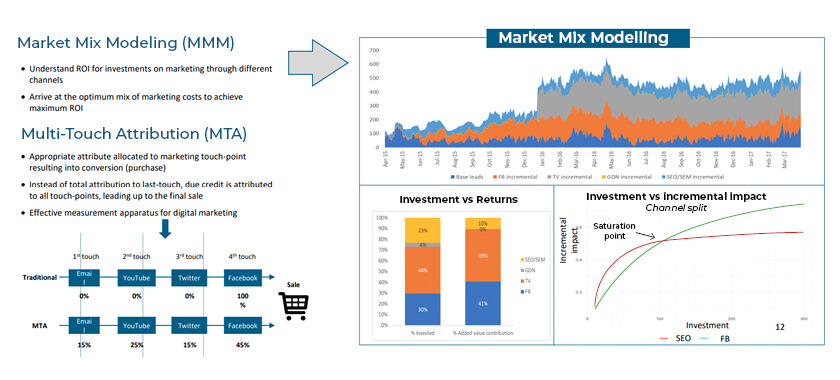Account-based marketing (ABM) programs act as a core strategy for businesses, designed to deliver growth and awareness with high-value accounts. Over 75% of marketers say that ABM improves customer lifetime values and delivers higher ROI than traditional go-to-market approaches. However, one in five B2B marketers faces ABM challenges that can impact long-term relationships with the top accounts on their radar.
Identifying these issues and overcoming them can help you stay focused on the right accounts and achieve great results. In this article, we elaborate on the top four ABM challenges and their respective solutions.
Challenge 1: Aligning marketing and sales teams to work towards the same goal
42% of marketers can’t run effective account-based marketing programs as it is difficult to align their marketing and sales teams. Marketers are responsible for all the activities needed to persuade target customers. The sales team has the responsibility to build personal connections and close deals. While both teams need to focus on a mutual end goal i.e. driving more revenue, they often operate in silos. This further leads to two ABM challenges:
- Alignment of marketing and sales qualified leads
The majority of B2B marketers are not currently realizing the value of good lead qualification and nurturing process. 61% of B2B marketers send all leads directly to sales – but only 27% of those leads will be qualified. All too often, sales development reps wait around until an MQL gets nurtured by marketing automation to contact the ‘warm lead’ (now an SQL) who may or may not be a decision-maker in the purchase.
- Identification of target accounts with a focus on whale accounts
Developing a manageable, scalable process that identifies the right fit accounts is a challenge for almost 70% of marketers. Moreover, understanding exactly how to reach the customer at an opportunistic time in the buying journey is difficult. Keeping the 80/20 rule in mind (80% of a company’s revenue is generated by 20% of its customers), marketers may still fail to approach and convince key stakeholders (C-level) at the whale accounts.
The solution
Moving from traditional sales and marketing silos to a combined vision and results-oriented ABM effort is the way to move forward. Hubspot’s Director of Sales, Dan Tyre and CMO, Mike Volpe introduced the concept of a ‘Smarketing team’. This focuses on consistent communication and collaboration to provide companies with a competitive advantage. How?
When marketers work closely with the sales team to gather insight into each account, the latter can provide updated information on which key accounts to target and what they are most interested in engaging with. This can help companies acquire and engage with high-value accounts time and cost-effectively. Furthermore, marketers may already be conducting inbound activities. So, they can use the existing pool of inbound leads to identify high-value opportunities for ABM activities.
Insight-driven account intelligence can provide insights into high-value accounts. It can pave the way for new opportunities to expand into whale accounts. These opportunities include but are not limited to business expansion, acquiring the logos, up-selling and cross-selling, and deal acceleration.
One of the world’s largest IT services and computer equipment firms leveraged our account intelligence expertise to tailor its sales pitches and acquire high-value clients to effectively meet the business goals. Read here.
Challenge 2: Identifying and engaging with the right people within a key account
The earlier you can identify key decision-makers and pass their contact information onto the sales team, the more successful an ABM campaign will be. However, getting access to key decision-makers is easier said than done today.
75% of marketers can’t find the right contacts at companies matching target profiles. Plus, the number of people involved in a B2B purchase has grown from 5.4 to 6.8 buyers in two years. It is difficult for account-based sales teams to identify and talk to the right people at the right stage of buying journey.
The solution
Effective targeting requires deep insights into the account, its business goals, and organizational structure. Marketers also need to understand key decision-makers and find the best ways to reach them. This helps them and sales reps position products and tailor pitches in line with the needs of prospective clients.
Selling to organizations with multiple stakeholders poses a few key ABM challenges. To begin with, ABM teams need to understand who these stakeholders are and how their offerings might affect the stakeholders. A research-driven lead generation process can help engage with the right point of contact(s) within a key account. This includes diving deep into the following details:
- Job title and tenure
- Specific roles and responsibilities
- Decision-making hierarchy
- Activity/engagement (with vendors, competitors, industry experts)
- Skills and proficiency
- Aspirations and interests
By creating organizational charts and leveraging targeted executive profiling, organizations can successfully identify and engage with the key stakeholders in a specific department of an account to expand their reach. Rather than simply relying on a list of company names, ABM teams should consider mapping out the buying committee so that they can have a full multi-touch approach to the right stakeholders in each key account.
Challenge 3: Delivering personalized, scalable content specific to buyers’ needs
Over half of B2B buyers conduct independent research online before deciding on a solution. Usually, they come to a decision before they even contact the sales representative. Moreover, only 23% of buyers view sellers as a top resource for solving business problems.
Investing in and delivering the right content experience that keeps individuals in a target account engaged is one of the top ABM challenges. This is due to lack of insight into buyers’ needs. Since the prospects in the top, middle, and bottom funnels are all at different points in the buyer’s journey, ABM marketers will need to personalize content for each of the segments based on their specific needs.
The solution
To begin with, marketers must have a good understanding of stakeholders’ roles, responsibilities, interests, and aspirations (as discussed in the solution to the second challenge). Through this, they can develop effective marketing collateral including thought leadership content (insight-driven blogs, whitepapers, bylines, infographics, and video content) that address their buyer’s specific needs.
Furthermore, auditing existing content, maintaining a robust, high-quality content library, and timing the delivery of all marketing communications based on research-driven insights can help connect more meaningfully with the prospect. Since this is a more targeted approach, the ROI on 1:1 activity is also higher.
A leading IT consulting firm from the manufacturing industry leveraged our thought leadership content strategy solution to engage with decision-makers across companies and establish trust amongst existing clients. Read here.
Challenge 4: Measure and keep track of ABM activities
One of the toughest ABM challenges is measuring account-based activity and campaign success. Legacy marketing attribution technology ties pipeline and revenue to leads, not accounts. And traditional lead metrics don’t tell the whole story of an account’s path to purchase.
Meanwhile, technology vendors are rising up to the challenge by offering tools that can supplement a company’s existing marketing automation platform with account-based engagements. However, even the best technologies can’t fully deliver results without incorporating ABM metrics into the content strategy and lead management process.
The solution
From identifying target accounts, creating scalable, research-driven content, and nurturing leads to converting accounts, marketers need to apply the right analytical models at each stage of the ABM process to measure and decode the true results of their efforts.
With the help of marketing analytics, marketers can see the progression of the most valued accounts. For instance, this can allow them to compare verticals, regions, or accounts that have been exposed to ABM activities versus those that have not. Marketers can also classify accounts into segments that have not progressed to the next stage, and generate new actionable content to optimize performance. In turn, this allows companies to generate insights and recommendations that address the following questions:
- Are our ABM efforts generating positive results? (Quality of acquisitions, profitability index)
- How can we optimally utilize our ABM budget? (Marketing Mix Modeling)
- How are the leads responding to the ABM campaign at each touch-point? (Multi-Touch Attribution)

Conclusion
For 37% of marketers, getting an adequate budget and resources for account-based initiatives is one of the major ABM challenges that they need to address on priority. Plus, data quality issues hinder ABM’s success for 29% of marketers. Without relevant, in-depth, and accurate account and market data, most account-based marketing programs tend to stall.
Netscribes supports leading organizations by providing reliable account data and insights and creating research-driven content tailored to their prospective customers’ needs. As a result, marketers can focus on identifying new opportunities and earn better ROI on their account-based marketing programs.
To know more about how we can help you achieve better results from your account-based marketing programs, contact us.






